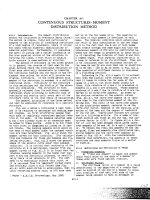SAP2000® Linear and Nonlinear Static and Dynamic Analysis and Design of Three-Dimensional Structures
Bạn đang xem bản rút gọn của tài liệu. Xem và tải ngay bản đầy đủ của tài liệu tại đây (920.27 KB, 47 trang )
SAP2000®
Linear and Nonlinear
Static and Dynamic
Analysis and Design
of
Three-Dimensional Structures
INTRODUCTORY TUTORIAL
Computers and Structures, Inc.
Berkeley, California, USA
Version 8.0
June 2002
Copyright
The computer program SAP2000 and all associated documentation are proprietary and
copyrighted products. Worldwide rights of ownership rest with Computers and
Structures, Inc. Unlicensed use of the program or reproduction of the documentation in
any form, without prior written authorization from Computers and Structures, Inc., is
explicitly prohibited.
Further information and copies of this documentation may be obtained from:
Computers and Structures, Inc.
1995 University Avenue
Berkeley, California 94704 USA
Phone: (510) 845-2177
FAX: (510) 845-4096
e-mail: (for general questions)
e-mail: (for technical support questions)
web: www.csiberkeley.com
Copyright Computers and Structures, Inc., 1978-2002.
The CSI Logo is a registered trademark of Computers and Structures, Inc.
SAP2000 is a registered trademark of Computers and Structures, Inc.
Windows is a registered trademark of Microsoft Corporation.
Adobe and Acrobat are registered trademarks of Adobe Systems Incorporated.
DISCLAIMER
CONSIDERABLE TIME, EFFORT AND EXPENSE HAVE GONE INTO THE
DEVELOPMENT AND DOCUMENTATION OF SAP2000. THE PROGRAM HAS
BEEN THOROUGHLY TESTED AND USED. IN USING THE PROGRAM,
HOWEVER, THE USER ACCEPTS AND UNDERSTANDS THAT NO WARRANTY
IS EXPRESSED OR IMPLIED BY THE DEVELOPERS OR THE DISTRIBUTORS
ON THE ACCURACY OR THE RELIABILITY OF THE PROGRAM.
THE USER MUST EXPLICITLY UNDERSTAND THE ASSUMPTIONS OF THE
PROGRAM AND MUST INDEPENDENTLY VERIFY THE RESULTS.
Contents
Introductory Tutorial for SAP2000
1
2
Introduction
Using This Manual
1-1
Overview of the Program
1-2
Using this Tutorial
1-2
An Introductory Tutorial
The Project
2-2
The Interface
2-2
Step 1
2-3
Begin a New Model
Define an Auto Select Section
List
2-6
Step 2
Add Frame Objects
Draw Frame Objects
Replicating Objects
Trimming Objects
Assigning Member End Releases
Save the Model
2-10
2-10
2-11
2-14
2-17
2-19
Step 3
Add Area Objects
Define the Area Sections
Draw the Area Object
Mesh the Area Object
2-19
2-19
2-20
2-22
Step 4
Add Restraints
2-23
i
Introductory Tutorial for SAP2000 Version 8
Step 5
Define Load Cases
2-25
Step 6
Assign Gravity Loads
2-26
Step 7
Assign Area Stiffness Modifiers
2-28
Step 8
Run the Analysis
2-29
Step 9
Graphically Review the Analysis
Results
2-30
Design the Steel Frame Objects
2-34
Step 10
ii
1
Chapter 1
Introduction
Using this Manual
This manual introduces you to SAP2000 Version 8. The step-by-step instructions guide you through development of your first model. The intent
is to demonstrate the fundamentals and to show how quickly and easily a
model can be created using this program. This tutorial is intended to give
you hands-on experience working with SAP2000, which for most people,
is the quickest way to become familiar with the program.
SAP2000 is an extremely versatile and powerful program with many features and functions. This manual does not attempt to fully document all
of those capabilities. Rather, we briefly show how to work with the program, providing some commentary along the way. To grasp the full
value of SAP2000, you should use this introductory tutorial manual in
conjunction with the other SAP2000 documentation.
We hope that you enjoy using this tutorial, and that you find it beneficial
as a starting point in your exploration of this powerful and comprehensive version of SAP2000.
Using this Manual
1-1
Introductory Tutorial for SAP2000 Version 8
1
Overview of the Program
SAP2000 is a stand-alone finite-element-based structural program for the
analysis and design of civil structures. It offers an intuitive, yet powerful
user interface with many tools to aid in the quick and accurate construction of models, along with the sophisticated analytical techniques needed
to do the most complex projects.
SAP2000 is object based, meaning that the models are created with
members that represent the physical reality. A beam with multiple members framing into it is created as a single object, just as it exists in the
real world, and the subdividing needed to ensure that connectivity exists
with the other members is handled internally by the program. Results for
analysis and design are reported for the overall object, and not for each
sub-element that makes up the object, providing information that is both
easier to interpret and more consistent with the physical structure.
Using this Tutorial
The example in this tutorial provides a step-by-step description of how to
use SAP2000. We recommend that you actually perform these steps in
SAP2000 while reading this manual.
The SAP2000 program must be installed on your computer before you
can begin the tutorial. It would also be a good idea to peruse the other
SAP2000 documentation prior to starting this tutorial, or at least have
them readily available if needed.
If you are viewing this tutorial manual as a .pdf file, we strongly recommend that you print it out before starting the tutorial. It will not be practical to use the SAP2000 program while trying to read this manual on
your computer screen.
During the course of this tutorial, we will explore many of the basic features of SAP2000. Prepare to spend at least one hour going through this
example, and if at any time you need to stop, save your model so that
you may continue at a later time.
Welcome to SAP2000.
1-2
Overview of the Program
2
Chapter 2
An Introductory Tutorial
This chapter provides step-by-step instructions for building a basic
SAP2000 model. Each step of the model creation process is identified,
and various model construction techniques are introduced. At the completion of this chapter, you will have built the model shown in Figure 1.
Figure 1
The Tutorial
Model
2-1
Introductory Tutorial for SAP2000 Version 8
The Project
The tutorial project is a five panel, sloped truss bridge. The bridge spans
60 feet, and has a width and height of 12 feet each. The supports are rollers at one end, and pins at the other.
2
The trusses and cross members are to be constructed of 2L4X4’s, while
the deck will be a concrete slab 5 inches thick. The bridge will be analyzed for static loads only, and the deck will be loaded with a Dead Load
= 10 pounds per square foot (psf) and a Live Load = 100 psf.
The Interface
The top menu line contains all of the commands and options available to
SAP2000, including Define, Draw, Select, Assign, Analyze, Display and
Design. These listed menus contain the commands that will be needed
most often when using SAP2000, and many of the most frequently used
commands are accessible as a single click button in the screen regions
surrounding the drawing areas. The availability of a button is indicated
in the main menus by the existence of an icon to the left of the command.
The lower right corner shows the current unit selection. Figure 2 shows
the layout of the interface.
Figure 2
The Interface
Menu Line
Units
2-2
The Project
Chapter 2 - An Introductory Tutorial
Step 1 Begin a New Model
In this Step, the basic grid will be defined which will serve as a template
for developing the model. Then a list of double angle sections will be selected for the truss Auto Select list.
A. Click the File menu > New Model command or the New Model button
. The form shown in Figure 3 will display. Verify that the default units are set to Kip-in.
Figure 3
Model
Templates
B. The Model Template form allows for the quick generation of numerous model types using parametric generation techniques. However,
in this tutorial the model will be started using only the grid generation. When laying out the grid, it is important that the geometry defined accurately represents the major geometrical aspects of the
Step 1 Begin a New Model
2-3
2
Introductory Tutorial for SAP2000 Version 8
model, so it is advisable to spend time carefully planning the number
and spacing of the grid lines. Select the Grid Only button, and the
form shown in Figure 4 will display.
2
Figure 4
New Coord/Grid
System form
C. The New Coord/Grid System form is used to specify the grids and
spacing in the X, Y and Z direction. Set the number of grid spaces to
10 for the X direction, and to 1 for the Y and Z directions. Type 6 ft
into the X direction spacing edit box and press the Enter key on your
keyboard. Note that the program automatically converts the 6 ft to
72 to be consistent with the default units of inches. Enter 12 ft or
144 for both the Y and Z direction spacing.
2-4
Step 1 Begin a New Model
Chapter 2 - An Introductory Tutorial
2
Display Title Bar (active)
Global Axes
Figure 5
The SAP2000
windows
D. Click the OK button to accept the changes, and Figure 5 will appear.
The grids appear in two view windows tiled vertically, a X-Y “Plan”
View on the left and a 3-D View on the right, as shown above. The
number of view windows may be changed by selecting the Options
menu > Windows command.
Notice that the “Plan” view is active in Figure 5. When the window is active, the display title bar is highlighted. Set a view active by clicking
anywhere in the view window.
Note that the Global Axes are displayed as well, and that Z positive is in
the “up” direction. When SAP2000 refers to the direction of gravity, this
is in the negative Z direction, or “down”.
Step 1 Begin a New Model
2-5
Introductory Tutorial for SAP2000 Version 8
Define an Auto Select Section List
An auto select section list is simply a list of sections, which for this tutorial will be a set of double angles (2L4X4’s). Auto select section lists are
assigned to frame objects in the same manner as an individual section
property. When an auto select section list is assigned to a frame object,
the program can automatically select the most economical, adequate section from the list when designing the member. When performing the initial analysis, the program will assign the median section from the list for
the analysis properties.
2
For this particular tutorial, the program will analyze and design from a
set of double angles, which will be chosen from an auto select sections
list created now.
A. Click the Define menu > Frame/Cable Sections command, which
will display the Frame Properties form shown in Figure 6.
Figure 6
The Frame
Properties
form
B. Scroll down the sections listed under Properties to see if the list contains 2L4X4’s, and if it does, skip ahead to Step D. Otherwise, proceed to Step C.
2-6
Step 1 Begin a New Model
Chapter 2 - An Introductory Tutorial
C. Click the drop-down box that reads “Import I/Wide Flange” in the
Choose Property Type for Add area of the form. Scroll down the list
of import options until you find Import Double Angle – see Figure 7.
Single click on it.
Figure 7
Import
Double
Angle
D. In the Click to area of the Frame Properties form, click the Add New
Property button, which will open the Section Property File form.
E. Select and open the file named SECTIONS8.PRO from the Section
Property File form, as this file contains the properties of the double
angles to be used in the model. The Sections8.pro sections list form
shown in Figure 8 appears.
F. Scroll down the list of double angles in the Sections Labels area until
you find the first 2L4X4. Click once on that member to highlight it.
G. Scroll further down the list until you find the last 2L4X4. Hold down
the Shift key on your keyboard and click once on the last
2L4X4X7/16 – all of the 2L4X4’s should now be highlighted.
Step 1 Begin a New Model
2-7
2
Introductory Tutorial for SAP2000 Version 8
H. Click the OK button, and then click the OK button in the Double
Angle Section form to add the angles selected to the list in the Properties area on the Frame Properties form.
2
Figure 8
Sections8.pro
sections
list
I.
Click the drop-down box that reads “Add I/Wide Flange” in the
Choose Property Type for Add area of the Frame Properties form
and scroll down until you locate Add Auto Select. Single click on it.
J. In the Click To area of the Frame Properties form, click the Add
New Property button, which will open the Auto Selection Sections
form shown in Figure 9.
K. Type TRUSS in the Auto Section Name edit box.
2-8
Step 1 Begin a New Model
Chapter 2 - An Introductory Tutorial
2
Figure 9
Auto
Selection
Sections
form
L. Scroll down the List of Sections to find the 2L4X4X1/2 double angle, and
click once to highlight it.
M. Continue down the list until you find the last double angle, 2L4X4X7/16, and
while holding down the shift key on the keyboard, click once on this section.
All of the 2L4X4’s should now be highlighted.
N. Click the Add button to move the selected list to the Auto Selections edit box
on the right side of the form.
O. Click the OK button and then click the OK button on the Frame Properties
form to accept your changes and add the TRUSS auto select list to the Properties edit box.
Step 1 Begin a New Model
2-9
Introductory Tutorial for SAP2000 Version 8
Step 2 Add Frame Objects
In this Step, Frame objects with the associated TRUSS sections list are
drawn using the grids and snap-to options, and generated with Edit menu
commands.
2
Draw Frame Objects
Make sure that the X-Y Plane @ Z=0 view (plan at lowest elevation) is
active (see Step1-D for directions on how to make a view active and
page 2-14 for setting the view). This view should be in the left window.
Also check that the Snap to Points and Grid Intersections command is
active. This will assist in accurately positioning the frame objects. This
command is active when its associated button
is depressed. Alternatively, use the Draw menu > Snap to > Points and Grid Intersections
command. By default, this command is active.
button or use the Draw menu >
A. Click the Draw Frame/Cable
Draw Frame/Cable command. If you accessed the Draw
Frame/Cable command via the Draw menu, the Draw Frame/Cable
button will depress verifying your command selection. The Properties of Object pop-up box for frames will appear as shown in Figure
10.
Figure 10
Properties of
Object box
If the Properties of Object box is covering any part of the model in
either view, drag it out of the way.
B. Click in the Property edit box on the Properties of Object form and
scroll down to TRUSS. Single click on it to assign the auto select list
TRUSS to the members you will draw.
2 - 10
Step 2 Add Frame Objects
Chapter 2 - An Introductory Tutorial
C. To draw the first frame object, left click once in the X-Y Plane view
at the X-Y origin, and then click again at the far right end along the
same horizontal grid line (x=720, y=0). The cursor location is indicated in the lower right-hand corner of the interface. A frame line
should appear in both views (plan and 3D). After clicking to define
the end point of the frame object, a right click will “lift the pen” so
you will no longer be actively drawing, but will leave the Draw
Frame/Cable command active so that you may add additional elements.
If you have made a mistake while drawing this object, click the Select Object
button, to leave the Draw mode and go to the Select
mode. Then click the Edit menu > Undo Frame Add command,
and repeat Items A-C.
D. Repeat Item C, drawing an additional frame object parallel to the
first member from (x=0, y=144) to (x=720, y=144). These members
form the bottom chords of the trusses. Right click to stop drawing.
E. Left click at (x=0, y=0) and then at (x=0, y=144) to draw the first
transverse member.
F. Click on the Select Object
button, or Press the Esc key on the
keyboard to exit the Draw Frame/Cable command.
Replicating Objects
Make sure that the program is in the Select mode.
A. Select the transverse member spanning between the longitudinal
chords by a left click directly on the member, or left click to the right
of the object, and while holding the left mouse button down, drag the
mouse across the member. See Figure 12 for selection options.
B. Click the Edit menu > Replicate command to bring up the form
shown in Figure 11.
C. On the Linear tab, type 144 into the dx edit box.
D. Type 5 into the Number edit box.
Step 2 Add Frame Objects
2 - 11
2
Introductory Tutorial for SAP2000 Version 8
E. Click the OK button. Note that transverse members have been generated at every other grid line.
2
Figure 11
Replicate
box
Right to Left Window Select
Selects everything in contact with window
Figure 12
Graphical
Selection
Options
Left to Right Window Select
Selects everything within the window
2 - 12
Step 2 Add Frame Objects
Direct Select
Selects only single object








